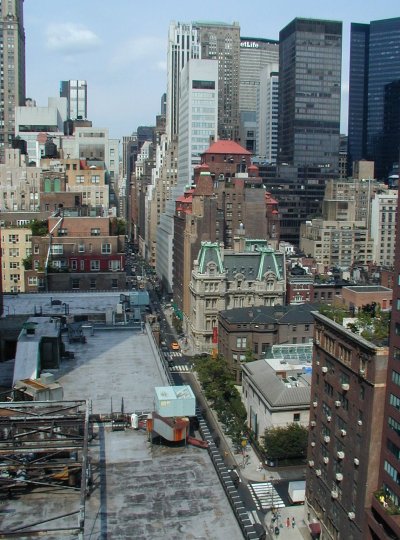The Skycitiy
Today, the skycity. The University of Houston's College of Engineering presents this series about the machines that make our civilization run, and the people whose ingenuity created them.
Charles Jencks' book on Skyscrapers offers a typology of tall buildings. He suggests three basic forms: skyprickers, skyscrapers, and skycities. The Empire State building, with its pointed spire, is a classic skypricker. His skyscrapers are the tall slablike buildings we see all around us, rendered in steel and glass.
But Jencks sees the skycity as where all this upward building is headed. A skycity is a cluster of interrelated tall buildings. That idea began drawing in architects, designers, and planners soon after the first steel-frame skyscraper, in 1885.
Twenty years later pictures of such cities began appearing. They were copied, circulated, and made into postcards. The idea had struck a nerve. You saw flocks of primitive airships moving among the spires. Ribbons of highway, high above the ground, were traveled by trains, since the automobile had yet to catch up with the dream. But we had to feel unsure as to just what lay below all that.
King Camp Gillette published one of the first books to describe such a city in 1894 -- the year before he invented the safety razor and became a wealthy capitalist. Gillette described a Utopian socialist society. He wrote, "Selfishness would be unknown, and war would be a barbarism of the past." The most bizarre feature of his Utopia was that all sixty million Americans would live in one great city.
Here, perhaps for the first time, the word Metropolis appears as a proper noun. Metropolis was to be a great complex of 25-story buildings, arranged in a honey-comb of hexagonal blocks. It was to occupy a thirty-mile-wide strip running 120 miles along the southern border of Lake Ontario, and including Niagara Falls as its power source. It was Jenck's skycity, a century before Jencks.
Although Gillette's Metropolis is itself almost forgotten, the skycity idea gained momentum. It was a Gothic vision, right down to the gargoyles and ornate towers of the old cathedrals. Only upper ribbons of highways now replaced the flying buttresses.
Wanamaker's department store made a formal assembly of this idea in an art exhibition called, "The Titan City, A Pictorial Prophesy of New York, 1926-2026." A year later, Fritz Lang's movie titled Metropolis came out of Germany. Lang knew that such a city would have lower depths we hadn't yet seen. He showed a pampered upper class, living in luxury far above the ground, served by an army of slave laborers in the hellish underground below.
After that, the idea crumbled. Skyscraper-building itself almost ended. The Depression brought growth to a halt and automobiles began dispersing cities. But Metropolis was another stake in the heart of the skycity. It's taken until now for skywalks and underground tunnel systems to begin knitting the great buildings of our cities into single complexes. Only now, as that movie fades in our memory, has the skycity idea finally begun its comeback.
I'm John Lienhard, at the University of Houston, where we're interested in the way inventive minds work.
(Theme music)
Jencks, C., Skyscrapers-Skyprickers-Skycities. (New York: Rizzoli International Publications, Inc. 1980).
Gillette, K.C., The Human Drift. (Boston: New Era Publishing Co., 1894). (This was the first of several books in which Gillette set down his ideas. The dedication reads: "The thoughts herein contained are dedicated to all mankind; for to all the hope of escape from an environment of injustice, poverty, and crime, is equally desirable.")
Gillette, K.C., The People's Corporation. (New York: Boni and Liveright Publishers, 1924). (This was Gillette's last book, thirty years after the first. Here, the dedication says simply: "To MANKIND.")
Mansfield, J., The Razor King. American Heritage of Invention and Technology, Spring 1992, pp. 40-46.
C. Mierop, Skyscrapers: Higher and Higher. (Brussels: Norma Editions, 1995).
C. Willis, The Titan City. American Heritage of Invention and Technology, Vol. 2, No. 2, Fall 1986, pp. 44-49.
N. Messler, The Art Deco Skyscraper in New York. (New York: Peter Lang Publishing, Inc. 1986).

Perhaps New York City is already closer to being a skycity than we think.
(photo by John Lienhard)